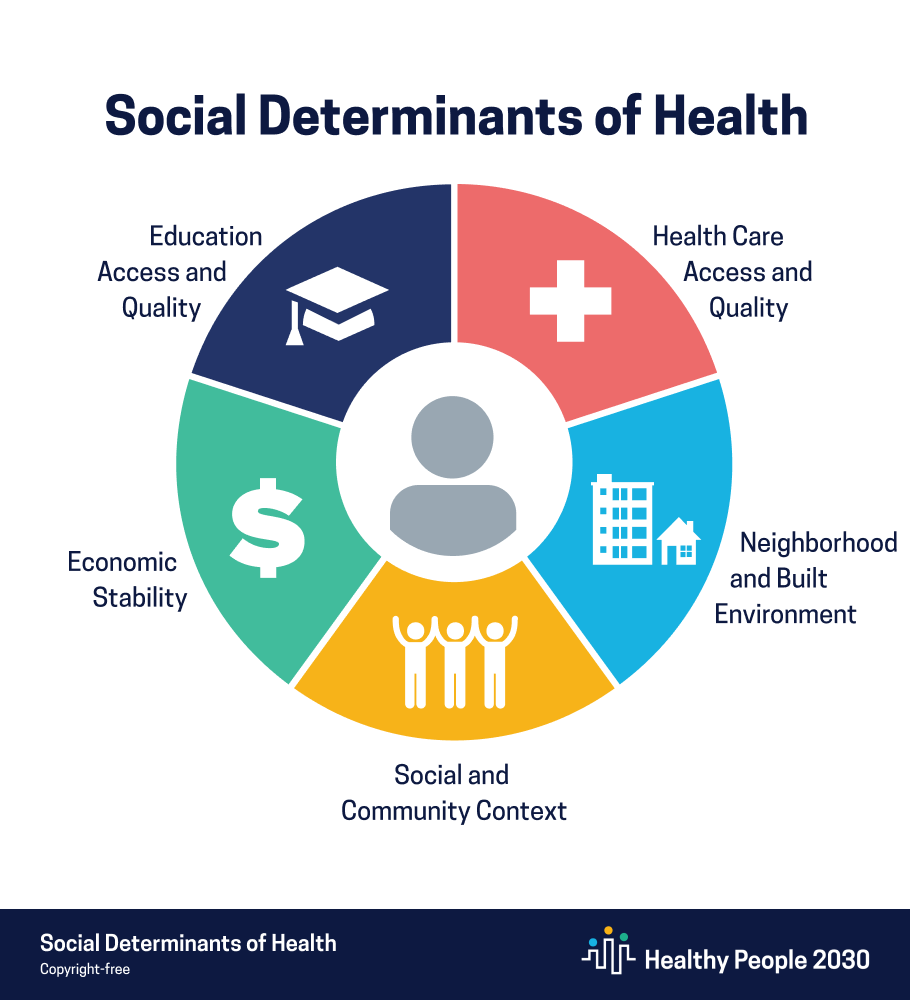Structural racism, slavery, discrimination, and colonial medicine have historically impacted access to healthcare in the United States. But other forms of historical discrimination disproportionally affect many groups, including people with low incomes, immigrants, people with chronic conditions, and people with mental health conditions (Corscadden et al., 2018). Historical discrimination is related to social determinants of health such as lack of access to health insurance, redlining and gentrification, rural health disparities, LGBTQ discrimination, gender discrimination and violence, and health inequities in perinatal care.
Social Inequalities in Health (NIH) [3:02]
https://www.youtube.com/watch?v=roAQHn5rEoQ
Social Determinants of Health and Access to Healthcare Services
Social determinants of health are conditions in the environment that affect a person’s health, functioning, and quality-of-life. Resources that enhance quality of life, such as safe and affordable housing, access to education, public safety, availability of healthy foods, local health services, and environments free of life-threatening toxins can have a significant influence on population health outcomes (ODPHP, 2022). Social determinants of health affect people throughout the lifespan.

Social determinants of health are often grouped into the 5 domains illustrated above. Source: ODPHP. See References for citation and web address.
Most Americans are unaware of these social determinants, do not understand what causes them, and do not necessarily find them to be unfair. In 2008–2009, a national survey showed that 73% of respondents were aware of health differences between the poor and middle-class people, but less than half reported awareness of health differences between White and Black Americans. Many respondents placed the responsibility for poor outcomes on individual behaviors such as smoking, diet, and exercise, as well as access to clinical care, and less on the social determinants of health. Understanding how social determinants affect health equity has led healthcare organizations and providers to recognize the need to address persistently poor health outcomes that affect certain groups (Towe et al., 2021).
Access to Health Insurance
Access to comprehensive health insurance is a key factor in whether, when, and where people get medical care. Uninsured people are far more likely than those with insurance to postpone or forego healthcare. Being uninsured can have severe financial consequences, with many unable to pay their medical bills, resulting in medical debt (Guth and Artiga, 2022).
Despite most people of color having a full-time worker in the family, they may be employed in low-wage jobs that are less likely to offer health insurance. While private insurance is the largest source of health coverage for people across racial and ethnic groups, people of color are less likely to be privately insured than White people (Guth and Artiga, 2022).
Redlining and Gentrification
Redlining and gentrification are historical social practices that we may not consider as contributing to gaps in health. Redlining is a practice in which lenders deny mortgages to eligible buyers solely because of their race. This practice, once widespread, assured that people of color were denied the right of home ownership and upward economic mobility that millions of White people enjoyed (Julian, Hardeman, and Huerto, 2020).
Redlining has been succeeded by gentrification, whereby wealthier middle-class people move into urban areas and displace people who have lived in a neighborhood for years. Both redlining and gentrification perpetuate poverty in communities of color. As such, many Black and low-income Americans live in communities where clean water isn’t guaranteed, and social distancing is nearly impossible in crowded homes. Redlining and gentrification greatly impacted the racial inequities seen during the COVID-19 pandemic (Julian, Hardeman, and Huerto, 2020).
Rural Healthcare Disparities
Rural populations make up approximately 19% of the U.S. population. These areas have heightened mortality rates from several chronic diseases compared to urban populations. A lack of rural hospitals and clinics, lack of access to specialty services, and high turnover rates among healthcare providers create significant health discrepancies for rural communities. Additionally, higher rates of poverty, behavioral risk factors, larger proportions of older adults and people with disabilities, and lower rates of insurance and education create disparities (Nuako et al., 2022).
Medically underserved areas (MUA) are areas where certain populations—usually rural—are subject to a lack of primary care and have high levels of poverty, infant mortality, and large numbers of elderly residents. More than 11,000,000 in California live in an area with a shortage of primary healthcare providers. This means that people in these areas do not have primary care doctors, must drive long distances for healthcare services, and often do not have access to specialty services. California has the largest number of medically underserved areas and medically underserved populations in the country (Garner, 2022).
Discrimination in LGBTQ+ Healthcare
LGBTQ+ individuals face significant disparities in physical and mental health outcomes. Compared to their heterosexual counterparts, LGBTQ+ patients have higher rates of anal cancer, asthma, cardiovascular disease, obesity, substance abuse, cigarette smoking, and suicide (Morris et al., 2019).
Sexual minority women report fewer lifetime Pap tests, transgender youth have less access to healthcare, and LGBTQ+ individuals are more likely to delay or avoid necessary medical care compared to heterosexual individuals. These disparities are due, in part, to lower healthcare utilization by LGBTQ+ individuals (Morris et al., 2019).
Perceived discrimination from healthcare providers and denial of healthcare altogether are common experiences among LGBTQ+ patients and have been identified as contributing factors to health disparities. Disparities in healthcare access and outcomes experienced by LGBTQ+ patients are compounded by vulnerabilities linked to racial identity and geographic location (Morris et al., 2019).
